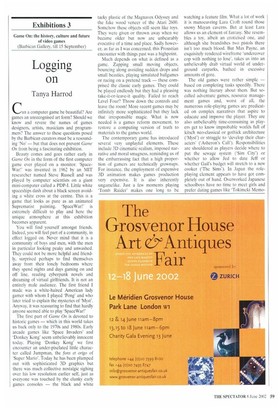Exhibitions 3
Game On: the history, culture and future of video games (Barbican Gallery, till 15 September)
Logging on
Tanya Harrod
Can a computer game be beautiful? Are games an unrecognised art form? Should we know and revere the names of games designers, artists, musicians and programmers? The answer to these questions posed by the Barbican curators must be a resounding 'No — but that does not prevent Game On from being a fascinating exhibition.
Beauty comes and goes rather early in Game On in the form of the first computer game ever played on a monitor. 'SpaceWar?' was invented in 1962 by an MIT researcher named Steve Russell and was played by computer scientists on a giant mini-computer called a PDP-I. Little white spaceships dash about a black screen avoiding a white cross at the centre. This is a game that looks as pure as an animated Suprematist painting. 'SpaceWar!' is extremely difficult to play and here the unique atmosphere at this exhibition becomes apparent.
You will find yourself amongst friends. Indeed, you will feel part of a community, in effect logged on. Never mind that it is a community of boys and men, with the men in particular looking peaky and unwashed. They could not be more helpful and friendly, surprised perhaps to find themselves away from their lonely bedrooms where they spend nights and days gaming on and off line, reading cyberpunk novels and dreaming of virtual girlfriends. It is not an entirely male audience. The first friend I made was a white-haired American lady gamer with whom I played Tong' and who later tried to explain the mysteries of 'Myst'. Anyway, it was reassuring to find that hardly anyone seemed able to play 'SpaceWar!'
The first part of Game On is devoted to historic games — which in this world takes us back only to the 1970s and 1980s. Early arcade games like 'Space Invaders' and 'Donkey Kong' seem unbelievably innocent today. Playing 'Donkey Kong' we first encounter an under-pixelated little character called Jumpman, the fons et origo of 'Super Mario'. Today he has been plumped Out with sophisticated 3D graphics but there was much collective nostalgic sighing over his low resolution earlier self, just as everyone was touched by the clunky early games consoles — the black and white tacky plastic of the Magnavox Odyssey and the fake wood veneer of the Atari 2600. Somehow these objects still seem like toys. They were given or thrown away when we became older but now are unbearably evocative of a time and place. Sadly however, as far as I was concerned. this Proustian encounter with things past was a highpoint.
Much depends on what is defined as a game. Zapping small moving objects, bouncing along avoiding sudden drops and small beasties, playing simulated ballgames or racing on a pretend track — these comprised the classic early games. They could be played endlessly but they had a pleasing take-it-or-leave-it quality. Failed to reach Level Four? Throw down the controls and leave the room! More recent games may be infinitely more sophisticated but they lack that irresponsible magic. What is now needed is a games reform movement, to restore a computing version of truth to materials to the games world.
The contemporary game has introduced several very unplayful elements. These include 3D cinematic realism, imposed narrative and moral smugness, reminding us of the embarrassing fact that a high proportion of garners are technically grownups. For instance, the employment of expensive 3D animation makes games production very expensive. It is also inherently ungamelike. Just a few moments playing 'Tomb Raider' makes one long to be watching a feature film. What a lot of work it is manoeuvring Lara Croft round those snowy Mayan caverns. But at least Lara allows us an element of fantasy. She resembles a toy, albeit an eroticised one, and although she brandishes two pistols there isn't too much blood. But Max Payne, an exquisitely rendered wireframe 'undercover cop with nothing to lose', takes us into an unbelievably drab virtual world of underground carparks, bathed in excessive amounts of gore.
The old games were rather simple — based on completing tasks speedily. There was nothing literary about them. But socalled adventure games, resource management games and, worst of all, the numerous role-playing games are predicated on complex narratives that aspire to educate and improve the player. They are also unbelievably time-consuming as players get to know improbable worlds full of kitsch neo-classical or gothick architecture (Myst') or struggle to 'develop their characters' ('Asheron's Call'). Responsibilities are shouldered as players decide where to put the sewage system (`Sim City') or whether to allow Jed to date Jeff or whether Gail's budget will stretch to a new cooker ('The Sims'). In Japan the roleplaying element appears to have got completely out of hand. Overworked Japanese schoolboys have no time to meet girls and prefer dating games like Tokimeki Memo rial' to the real thing. The dating games bossily teach that the wrong sorts of interests will result in rejection. Those who succeed are rewarded with the softest of soft porn.
What a funny old postmodern world we live in. Of course, games are of huge interest to the American military. At the Institute for Creative Technologies (www.ott.navy.mil/view) the US Army have enlisted the talents of the games development industries in a five-year project to advance the state of immersive training simulation. This will enable soldiers to 'experience the sights, sounds and circumstances they will encounter in real-world scenarios'. Meanwhile the 11 September terrorists probably honed their skills with Flight Sims like 'Microsoft Flight Simulator'. Game On indeed.























































































 Previous page
Previous page